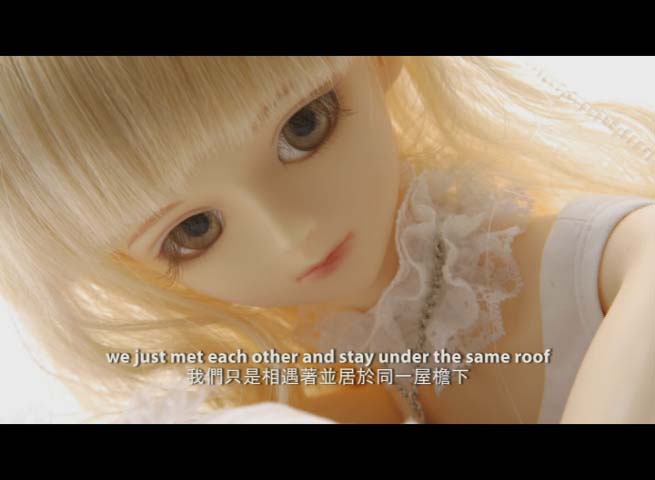
On the Japanese Doll Complex:
Introduction
Katrien Jacobs[1]
-
On the Japanese Doll-Complex highlights Chinese people's appropriation of Japanese dolls or doll-like alter egos. I conducted interviews with several people in Hong Kong, Taiwan and mainland China. I wanted to analyse the experience of 'owning a doll' or 'identifying with a doll' by looking at several kinds of doll fantasies and how dolls assist people in recovering innocence and gender-fluidity. Chinese men are massively into Japanese porn stars, into hentai figurines,[2] or life-size dolls that have a convincing and arousing skin texture. They also manifest themselves as cosplayers or cross-dressers who want to embody pretty girls. Women, on the other hand, construct fantasies about gay love and they impersonate the beautiful and effeminate men of yaoi animations (Boy Love).
 Figure 1. Superdollfie doll 'Layla.' Photographed by SD owner and photographer, Martin Lam. Still from On the Japanese Doll Complex.
Figure 1. Superdollfie doll 'Layla.' Photographed by SD owner and photographer, Martin Lam. Still from On the Japanese Doll Complex.
|
 Figure 2. Kigurumi cosplayers and cross-dressers from Taiwan. Source: Kigurumi, 8 August 2006, online: http://sharkgogo.myweb.hinet.net, accessed, 16 March 2009
Figure 2. Kigurumi cosplayers and cross-dressers from Taiwan. Source: Kigurumi, 8 August 2006, online: http://sharkgogo.myweb.hinet.net, accessed, 16 March 2009
|
:
-
In any case, I believe that Chinese people have fallen for 'Japanese-ness' as an anguished quest for idealised beauty and queer romance, for a purity and adventurousness that cannot be found in real life, for a subtle and modern sex appeal that is still quite taboo in the Confucian tradition. The Boy Love culture specifically allows young women to express their desires and creativity, to develop voices of excessive angst and frustration in finding a suitable kind of love or lover.
-
The video shows that people try to develop these shades of sexuality within the boundaries of commodity culture. Hong Kong may not admit it so easily, but I believe that people's fantasies and subjectivities are affected by the censorship politics of mainland China. As Lisa Rowel points out in Desiring China, modes of sexual innovation and restlessness can only be developed if they are divorced from the 'dangerous passions of politics.'[3] People identify with a 'Japanese' kind of openness and branding as an escape from the boundaries and stigmas within Chinese sex culture, but it cannot be defined as anything else but a desperate longing for the commodity.
-
I have to add that I also came to the Boy Love culture because of my own attachment to gay love stories and my actual relationships with gay men.
My long-standing interest in 'fag' authors like Edmund White, Jean Genet, or Truman Capote and my own bi-sexuality and love for gay men has unleashed a desire to experience life as fluctuating tastes and sexual orientations, either as a spectator or as an actual lover. I have defined myself with many others of the hyper-wired generation as a cross-voyeur rather than a voyeur. A cross-voyeur is a restless and curious person who wants to challenge his/her own natural sexual tastes and cultural education and exchange personalities to experience the atomization of sexuality and fetishism.

 Figures 3 and 4. Stills from BL Animation Music Videos, used in the documentary On the Japanese Doll Complex.
Figures 3 and 4. Stills from BL Animation Music Videos, used in the documentary On the Japanese Doll Complex.
|
-
That is what I felt when I first saw the web sites with the Super Dollfie dolls and doll parts made by the Japanese company Volks—hundreds of variations of eyes, eye balls, legs, hands, and hairstyles. Secondly, I also started to look at how Chinese people upload and remix Japanese animation videos in a genre called AMV (Animation Music Videos). In this genre fans sample and edit together their favorite scene of Japanese animation and add music or a soundtrack of their choice. I became specifically interested in the female-driven subgenre called 'Boy Love' which shows gay love and adventure stories, and is currently very popular on video sharing sites such as Youtube.com.
-
I realise that my queer values and desires may be a different from the Chinese fans of Boy Love, but as a scholar I do try to find intersections between their world and my own. I identify with Boy Love in all its adolescent probing and pettiness. I think some of the greatest sex stories and theories have been written by these kinds of actively frustrated minds and their yearning for affection or recognition. This is not so much an issue of Asian versus Western queerness, but one of Boy Love fitting into a long-established and well-accepted genre of romantic fiction that has existed in different cultures, for instance amour courtois in medieval France. I am interested in Boy Love because it is about excessive emotions, about pain, anxiety, trial and error, love and rejection. I hope that young people in Asia will take these complex shades of sexuality into adulthood, if not into a solidified public culture and queer politics.
Endnotes
[1] On the Japanese Doll Complex, Madame Remedy Video Series, Episode 2, 19 mins, 2008, produced and directed by Katrien Jacobs, edited by Alice Liu
[2] Hentai is a Japanese term literally meaning 'perverse.' It is used to describe a range of sexually perverse cultural products including manga and anime deriving from Japan. See Mark McLelland, 'A short History of Hentai,' in Intersections issue 12, January 2006, online: http://intersections.anu.edu.au/issue12/mclelland.html, accessed 13 March 2009.
[3] Lisa Rofel, Desiring China: Experiments in Neoliberalism, Sexuality, and Public Culture, Durham: Duke University Press, 2007, p. 121.
|



